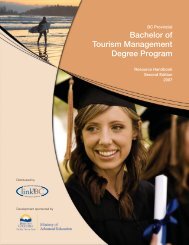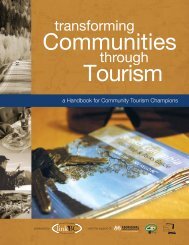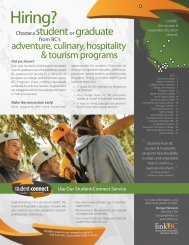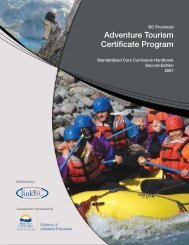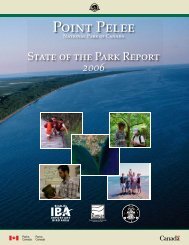Cultural Heritage Tourism Handbook - LinkBC
Cultural Heritage Tourism Handbook - LinkBC
Cultural Heritage Tourism Handbook - LinkBC
- No tags were found...
You also want an ePaper? Increase the reach of your titles
YUMPU automatically turns print PDFs into web optimized ePapers that Google loves.
9.2 Position Your Available ExperiencesAs communities use the knowledge gathered in their inventory, they will need to categorize availableexperiences in a way that shows their relative impact on the overall visitor experience. Thornecategorizes these in this way:When a community planning group assigns a cultural/heritageexperience to one of these categories, it is not a value judgmenton the experience. It is a helpful means for positioning each experiencewithin a marketing campaign that promotes a wide range ofcommunity experiences.Thorne describes the tool that he uses to help guide communitiesposition their cultural/heritage experiences as a product positioningmatrix (or PPM). Here is an example for the Human <strong>Heritage</strong> cluster:Using the framework provided by Steven Thorne, your communityshould be on its way to discovering your cultural character–“a centralelement in destination planning. It solidifies a vision. It shapes thebrand. It informs the marketing campaign through the developmentof themes. It provides a context for visitors to understand andinterpret the destination’s cultural experiences.”Human <strong>Heritage</strong>Product Positioning Matrix“Lead experiences are the destination’scultural/heritage tourism icons: itsmost developed and recognized cultural/heritage experiences. These could be:• a renowned museum or gallery• a signature arts, heritage, or culinaryfestival• a major First Nations attraction• a significant historic siteLead experiences have high standards ofquality, authenticity, interpretation, andvisitor service. Usually, lead experiencesalso have a tangible “wow factor.”Supporting experiencesare the destination’s second-tier cultural/heritage experiences. Usually, but not necessarily,they are less developed than leadexperiences and have less prominence inthe tourism marketplace. Although theygenerally lack the “wow factor” of leadexperiences, they are often no less culturallysignificant. Some examples that mightfit this category:• a farm or factory tour• a cluster of antique shops• a beautiful network of lake-side trails thatencourage visitors to stay longer• a walking tour of downtownAt minimum, supporting experiences havegood or acceptable standards of quality,authenticity, interpretation, and visitorservice.Sustaining experiences aremore limited in size and scope than leador supporting experiences, but often helpcreate memorable impressions of a community.They are sometimes seen as “tinyjewels” by visitors – for example:• an artist studio that lies off the beatentrack• a menu inspired by regional cuisine featuredat a rural restaurant loved by locals• a well-designed interpretive kiosk at ascenic wayside• a subject expert who provides the opportunityto learn something new, or to meetlocal people”Thorne further observes that sustainingexperiences, for example those provided bycommunity museums and events producedby non-profit arts groups, can sometimes beconstrained by limited resources. That said,sustaining experiences must, at minimum,have good or acceptable standards ofquality, authenticity, interpretation, andvisitor service.Experience Types Lead Supporting Sustaining TotalAboriginal heritage experiencesArchaeological sitesArchitectureArchives<strong>Cultural</strong> & historical districtsDecorative gardens<strong>Heritage</strong> events & festivals<strong>Heritage</strong> homes<strong>Heritage</strong> sitesHuman heritage museumsLibrariesLiving history sitesMonumentsStreetscapesOtherTotalThis next case study illustrates how a community can create andconvey a brand that allows visitors a clear understanding of theircultural character.68 69



